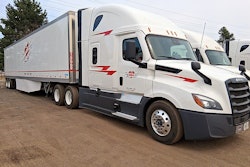Technology helps non-asset providers match freight and trucks more efficiently.
Non-asset transportation providers and arrangers may go by different names – carriers, brokers, agents, 3PLs, intermediaries, etc. – but ultimately they share the same resource: someone else’s truck capacity. Companies that are able to secure capacity quickly and consistently have the competitive edge. Increasingly, technology has become central to this effort.
Until early last year, J.H. Rose Logistics used a software package built primarily for asset-based carriers. The system lacked a process for managing carrier settlements, so the company relied heavily on Excel spreadsheets.
“Paying carriers on time is golden to us to maintain our credit rating,” says Amy Noyes, vice president of operations for the El Paso, Texas-based company. “That’s all they’ve got to look at.”
That’s why J.H. Rose Logistics switched to PowerBroker, an enterprise software system from McLeod Software developed specifically for brokerage and logistics companies. The company now processes settlement checks daily and pays carriers in as few as three days. Revenue increased by 25 percent last year without having to add additional staff, Noyes says.
“We did almost 3,000 more loads the first year,” she says. “You can’t attribute it all to software, but we did gain efficiencies.”
Major providers of trucking enterprise software see the third-party logistics segment and other non-asset transportation companies as a great prospect for new business development. Online freight matching services also recently have added more tools and resources to help brokerage and logistics companies capture capacity faster – and before their competitors do.
At the enterprise level
Some of the most recent technologies include new enterprise software packages and deeper integration between the different business systems used by brokers and carriers.
All of the major providers of trucking enterprise software offer a scalable base package with various fleet information systems such as dispatch and accounting. The majority of their clients own or operate equipment. Carriers that operate a separate logistics company – or those that are purely non-asset – traditionally would buy a base package from a software vendor, along with an add-on module for brokerage and logistics.
In April 2006, McLeod Software departed from this traditional model by releasing PowerBroker – developed from the start for non-asset companies like J.H. Rose Logistics. PowerBroker was developed using Java 2, Enterprise Edition technologies and has a Windows look and feel. One of the advantages of Java technology is that users see information on the screen in real time without having to hit a “refresh” button, says Rick Halbrooks, vice president of sales and marketing for McLeod Software.
“In the brokerage business, real-time information is huge,” Halbrooks says. “Decisions are made very rapidly on load boards. It is a lost opportunity if you are trying to figure out profitability.”
TransCore recently completed an extensive development project for its brokerage and logistics suite of products and services. In October 2006, the company brought together a number of different technologies and companies under a single platform – the 3sixty Operations Management suite. Brokerage and logistics companies can get operations, accounting, online freight matching, carrier qualification, rendition billing and imaging, dock management and more.
“The greatest asset of a non-asset based company is their data,” says Steve Blair, vice president and general manager of Operations Management for TransCore.
The 3sixty suite consists of six products, each of which TransCore sells separately or bundled together. Besides the Operations Management software for brokerage and logistics companies, the 3sixty suite includes a load board product – 3sixty Freight Match powered by DAT – and a carrier validation and monitoring system called CarrierWatch, says David Schrader, TransCore’s vice president of Freight Business Services.
In April, TransCore incorporated TIAWatchdog into its 3sixty suite. Through TIAWatchdog, members of the Transportation Intermediaries Association can report unethical business practices on motor carriers, or companies or individuals posing as motor carriers.
In April, Innovative Computing relaunched a module for its enterprise software called LoadCentral. The module provides a method to reduce manual labor – paper, faxes, e-mails, etc. – when tendering loads and available trucks between multiple parties. The different parties can include trucking companies, logistics divisions and other carriers and logistics firms that use the Innovative Enterprise System (IES) with LoadCentral.
“You set up shipper information, consignee and destination one time,” says Pat Brennan, LoadCentral and Logistics product manager for Innovative Computing. For example, a logistics company initially can tender a load to its trucking counterpart. If no truck is available, the company could offer it to another Innovative customer.
“When you offer a truck, it operates the same way as if it were an internal truck and load movement,” Brennan says. LoadCentral soon will include electronic data interchange (EDI) for logistics users to automatically receive current shipment status from carriers that use IES and mobile communications, Brennan says.
TMW Systems has seen a “real surge” in logistics firms that have purchased its core enterprise system, TMWSuite, because of its flexibility, reporting tools and comprehensive integration, says Monica Truelsch, director of product management.
TMW offers a carrier selection module for negotiating with and assigning loads to external carriers. Other useful applications include imaging, outbound load-tendering EDI capabilities, and new searching, filtering and sorting tools for identifying carriers by lane and equipment, Truelsch says.
Currently, TMW is developing new features for high-volume operations to speed throughput of certain information. One such feature is adapting its Intelligent Dispatch Assistant (IDA) for brokerage and logistics operations. IDA is a rudimentary power-to-load optimization tool for carriers.
The same intelligence used to assign a driver to a load can be used to assign a particular carrier to a load based on carrier qualifications and maximum-profit calculations, Truelsch says. Logistics companies then can make load offers automatically, with minimal human oversight.
“The tools we are putting together are really pushing the envelope of large-volume logistics assignment,” Truelsch says.
Freight matching
Enterprise software systems support the lion’s share of the information needs of brokerage and logistics companies, but even companies with an extensive database of carriers frequently must look online for capacity. One useful feature that is offered by several software companies is an interface to load boards to eliminate duplicate data entry.
McLeod has developed interfaces with TransCore, the Internet Truckstop and Getloaded.com, Halbrooks says. TMW currently interfaces with TransCore, Truelsch says. And TransCore’s 3sixty Operations Management interfaces with its own load board product, Freight Match powered by DAT.
“I post the ones that I don’t have carriers for,” says Tamara Dimitroff, vice president of Carrier Services of Tennessee, based in Mount Juliet, Tenn. “I can push three buttons and tell it to post every load. I can also set it up where it will automatically post without pushing buttons.”
Three years ago, Carrier Services began using a Unix-based enterprise system from TransCore, Keypoint, which is now called the 3sixty Operations Management suite.
Similarly, Chester, Va.-based VHI Transport uses an interface with Getloaded.com as “an extra tool for special loads,” says Mike Bennett, the company’s assistant director of operations.
Using an “internal load board” in its dispatch software, VHI Transport’s freight planners select loads to post to Getloaded.com, which instantly returns a list of potential matches based on city and origin. The company then can narrow the search down by trailer type, shipment timing, date available, full load and team required, among other filters. “We use Getloaded for all of our divisions – dedicated, air expedited, tanker and refrigerated,” Bennett says.
Getloaded recently added filtering and control options that include the length and weight of loads – particularly useful for LTL carriers – and pay amount. Getloaded.com soon will release a version of its website for mobile phones to search for loads, says Todd Nemanich, IT manager.
Grading fleets
The leading online freight matching services, or load boards, each have thousands of loads and trucks posted every day. With such a vast market of buyers and sellers of truck capacity, it is critical to know not just where capacity is available, but if the carrier is reliable.
The Internet Truckstop offers a “carrier performance rating,” a formula that blends together several critical performance measures into a letter grade (A to F), says Joel McGinley, a consultant for The Internet Truckstop. The criterion used to rate carrier performance includes the length of time in operation, size of the fleet, safety rating and out-of-service incidents.
The Internet Truckstop also supplies rates to assist brokerage companies in negotiating with carriers. Internet Truckstop’s Rate Mate product – which both brokers and carriers can access – provides average rates by equipment type and by lane. Users can analyze rates by date range – year over year, month by month and in the last seven days, McGinley says.
TransCore’s Freight Match powered by DAT and Getloaded.com also provide rate information through a third-party resource. Another rate negotiation tool that all three freight matching services provide is a supply and demand indicator for different geographic areas and lanes. The indicator is based on the number of postings of trucks versus loads.
Managing carriers
Brokerage and logistics companies are, first and foremost, a sales organization for two sets of customers – shippers and carriers. Increasing the efficiency of employees by providing them with better information and eliminating time-wasting processes can lead to more productive and profitable sales.
Dispatcher productivity at J.H. Rose Logistics has increased simply by having all the necessary information in one planning screen, Noyes says. Dispatchers can rearrange the Broker Planning screen in McLeod’s PowerBroker system any way they choose: They can list loads/orders at the top of the screen in various ways – by date, by progress and by those available to be picked up – and view available tractors on the bottom of the screen.
Dispatchers also quickly can see if any of the 6,000 active carriers in its database do not have current insurance, operating authority and contract commitments. They also can check on their shipper customer’s credit without scrolling through the system.
“We can see all aspects of what we consider to be important,” Noyes says.
Carrier settlements also have become more efficient. Settlement checks now are run daily instead of weekly, allowing the company to offer carriers quick pay options, from three days to three weeks from date of invoice. The company also offers electronic deposit to a checking account or purchasing card such as Comdata.
“If I tell a carrier I can pay in seven days, it is going to happen,” Noyes says.
The company also has reduced its days sales outstanding from 37 to 32 days. “We were able to speed up cash flow,” Noyes says. “In this business, that’s what it’s all about. We are able to do same-day billing when we process a carrier invoice.”
Since implementing TransCore’s Operations Management software in 2004, Carrier Services of Tennessee has increased its business by 50 percent, Dimitroff says. “I attribute it to being able to perform the same tasks we were doing before, but 90 percent faster,” Dimitroff says. For example, the software keeps track of all carriers that have hauled a particular load by lane, and the cost of each trip. “We used to have to hunt this down, and make lists,” Dimitroff says. The majority of its freight is covered within 10 minutes, she says.
“The technology itself is your competitive advantage – to search out and find the equipment,” Dimitroff says. “I always associate our business with the stock market. When it comes out, you have to get out there and cover it. You’ve got to be fast.”
REMOTE CONTROL
Technology helps logistics companies extend control, efficiency to agents
Brokerage and logistics operations often use agents to increase their business without adding additional staff and infrastructure. Agents typically are paid on straight commission and bring their own set of shippers and carriers – and in some cases, agents of their own. In turn, the brokerage and logistics company provides the administrative and information systems.
“When you have agencies, it is a question of control,” says Amy Noyes, vice president of operations at J.R. Rose Logistics, a transportation logistics provider based in El Paso, Texas. “Through the software, you can control what customers they look at. They only see loads that pertain to their terminal or agents.”
Noyes says such control includes enforcing the same company policies on credit rating – for both shipper and carrier qualifications – as those applied to employees. To manage its agent offices, J.R. Rose Logistics uses Agent Access, a Web-based add-on module from McLeod Software for its PowerBroker enterprise software system.
Software vendors have designed new features for managing agent relationships, providing brokerage and logistics companies a competitive advantage in recruiting and increasing the efficiency of its agents through technology.
“Our systems address a broker’s needs from a small agent to a full-service office,” says Steve Blair, vice president and general manager of Operations Management, one of six products in TransCore’s new 3sixty software suite. “The agent module of our Logistics Suite allows a broker to effectively manage an unlimited number of agent offices. The operations and carrier qualification functionality allow any user to take full advantage of the relationships with their carrier base.”
TMW Systems has a Web-based Agent Order Entry module that interfaces directly to its enterprise system, TMWSuite, to give agents remote order entry and dispatch capabilities, says Monica Truelsch, director of product management. The company also offers an Agent Pay module that helps automate settlements with numerous parties.
Major software vendors also offer Web-based private load boards that logistics firms use to connect directly with carriers to tender loads and receive shipment updates. These private load boards can be linked to separate Web-based load-tracking products to provide the customer, the shipper, with real-time status of their freight. Combined with document imaging, logistics companies also can make load documents, invoices and settlement checks available to shippers and carriers to self-service their needs, helping to keep people in the broker’s office focused on productive sales tasks, software developers say.










